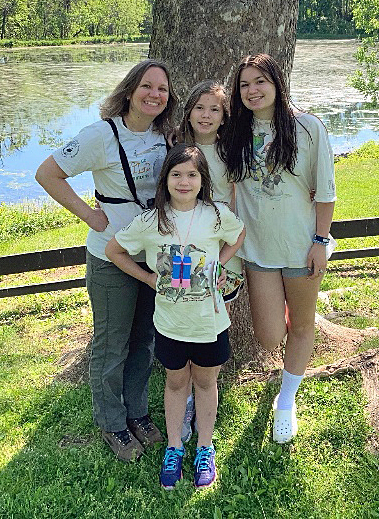by Gerco Hoogeweg, Raven Loonatics Birdathon Team Member
If you’re thinking about participating in the Birdathon, but you’re not sure where to start, read on. First, what exactly is the Birdathon? It’s a fun way for a team of people to count birds and raise money for Loudoun Wildlife Conservancy. You choose any 24-hour time period or a 48-hour time period from April 20 to May 19, 2024 and try to find as many bird species as you can in Loudoun County in that period. There are prizes for the team that finds the most species (as well as prizes for other categories). Of course, there are some rules you’ll need to follow, which are described in Forming a Birdathon team. If you participated in the Walk for Wildlife last fall, you’ll find that the rules for the Birdathon are quite different. You can read about the adventures of some of the Birdathon teams in the 2023 Birdathon Team Summaries.
How to Form a Team?

The Ligi Nestlings
Anyone can form at team. Birdathons are for birders of all levels and ages. A team typically consists four people, but smaller and larger teams participate as well. Doing a Birdathon with several people is more fun, and you’ll see more species because each team member is an extra set of eyes. Ask your birding friends and acquaintances if they have an interest and are available. You can also form a team with your family. We have had several family teams participate over the years. All you need to do is ask. If you don’t know who to ask, please reach out to us at contact@loudounwildlife.org to ask for suggestions.
What Time to Start?
Most bird activity is in the early morning and lasts until it gets too warm. If you want to see as many birds as possible, be prepared to start around 5:00 to 5:30am, or at least 30 to 60 minutes prior to sunrise at a primary location. If it gets warm quickly, much bird activity can be over as early as 9:00 to 10:00 am. During the rest of the day, it will be harder to find new species — a fun challenge.
Choose a Primary Location
For a strong start to a Birdathon, select a primary location. This location could be a park that you know well and has a good variety of habitats and birds. Prepare to spend several hours (at least two to three) in this location as it will set the tone for the day. Good locations are Algonkian Regional Park (main park or Sanctuary Trail), Bles Park, Sweet Run State Park, and Dulles Wetlands (permission is required for access; contact Joe Coleman at jcoleman@loudounwildlife.org). At most of these locations you should be able to find between 60 to 80 or more species. To find a good primary location near you visit the eBird Loudoun hotspot page. Via this page you can access the Loudoun County illustrated checklist page, which provides a nice overview of the species you can see in the county.
Afternoon Delight
Warm afternoons are the hardest part of a Birdathon. This a is great time to visit local wetlands or ponds. At these locations you may find lingering ducks, flycatchers and waders actively foraging or simply sleeping on the water. A quick 5 to 10 minute visit at several of the ponds in Ashburn, Broadlands Wetlands, or western Loudoun County can yield some unexpected birds. Remember, each bird species counts.
Diverse Habitats
To see many different bird species, you will need to visit different habitats. Include rivers (Algonkian Regional Park), ponds (Beaverdam Reservoir, Middlesex Drive Pond), wetlands (Broadland Wetlands), forested areas (Blue Ridge Center for Environmental Studies) and meadows (western Loudoun County) in your Birdathon route. This will require some driving around, but with a little planning, it’s possible to do it in a day or two.
Mistaken Identity
Yes, you will make mistakes trying to identify birds in the field. It doesn’t matter if you are a beginner or experienced birder. Birds will trick you. Birds in flight are especially a challenge when you get a brief look. If visual identification is hard, try to take a photo and identify the bird later using a field guide or the Merlin Bird ID app. As long as you saw the bird during the Birdathon, it counts.
Take it Easy
Speed isn’t everything. If you walk or drive too fast, you could miss a much-needed species such as a migrating Broad-winged Hawk or a breeding Osprey along Route 7. When driving, drive slowly and leave your windows open. You never know what bird you’ll hear.
Good luck and happy birding.


1 Comment
Leave your reply.